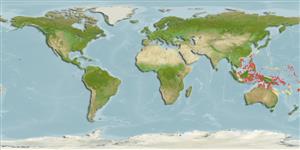Classification / Names
ชื่อสามัญ | ชื่อพ้อง | Catalog of Fishes(สกุล, ชนิด) | ITIS | CoL | WoRMS | Cloffa
>
Eupercaria/misc (Various families in series Eupercaria) >
Labridae (Wrasses) > Cheilininae
Etymology: Epibulus: Greek, epi = over, in front + Greek, boleo = to throw (Ref. 45335); brevis: Name from Latin meaning short, refers to its distinctly smaller size..
More on authors: Carlson, Randall & Dawson.
Environment: milieu / climate zone / depth range / distribution range
นิเวศวิทยา
เกี่ยวกับทะเล,น้ำเค็ม เกี่ยวกับหินโสโครก; ระดับความลึก 3 - 18 m (Ref. 75789). Tropical
Western Pacific: Palau, Philippines, Papua New Guinea and Indonesia.
ขนาด / น้ำหนัก / Age
Maturity: Lm ? range ? - ? cm
Max length : 18.5 cm SL เพศผู้/กระเทย; (Ref. 75789); 13.5 cm SL (female)
Short description
สัณฐานวิทยา | ความยาวต่างๆ
เงี่ยงครีบหลัง (รวม): 9; ก้านครีบอ่อนที่หาง (รวม): 10; เงี่ยงครีบก้น 3; ก้านครีบอ่อนที่ก้น: 8. This species is distinguished from its only congener Epibulus insidiator by the relatively drab coloration of the male; a prominent black pigment on the pectoral fins of most females (vs. absent); smaller size with slightly longer pectoral fins, 23.1-26.2% SL (vs. 20.5-23.3% SL); genetically as determined by mitochondrial DNA analysis; jaw structure very long, its posterior end nearly reaching origin of pelvic fins, and it is extremely protrusible; D IX, 10; A III, 9; pectoral rays 12; lateral line interrupted, 14-15 + 7-9 scales; gill rakers 16-19 (modally 17); females varying from dark to light brown, gray, yellow, to nearly white, with narrow black bar on scales of body except ventrally and posteriorly; males dark brown to gray or dark greenish on body, the head at least partly green with no black stripe through eye; yellow band in lobes of caudal fin; no black on pectoral fins (Ref. 75789).
This species inhabits protected inshore waters and is a protogynous hermaphrodite. It has been observed to spawn on several occasions in Palau at Ngerikuul (Nikko Bay) and Cemetery Reef (W side of Ngeruktabel) in the late afternoon, generally about 1600 when sunset is around 1800, and not correlated with high tide. Courtship and spawning were found to be variable; distinct from that of E. insidiator. The males do not display in such an obvious manner as E. insidiator, but they do swim conspicuously around a putative territory, often a short distance above the bottom, but sometimes higher in the water column, presumably to be more visible to the females. The male’s courtship posture is distinctly different from that of its congener, with caudal fin folded, and the dorsal and anal fins held closely to the body. The males swim around prospective females, displaying in a very subtle manner. The spawning rush varies, ranging from a low arch to a short and relatively slow upward movement. At the time of spawning the median fins of the male are more widely spread. Stomach contents contain remains of crabs and shrimps, and other unidentified crustaceans (Ref. 75789). A solitary species (Ref. 90102).
Life cycle and mating behavior
วัยเจริญพันธุ์ | การสืบพันธุ์ | การวางไข่ | เซลสืบพันธ์ของเพศเมีย(ไข่) | ความดกของไข่ | ตัวอ่อน
Oviparous, with distinct pairing during breeding (Ref. 205).
Carlson, B.A., J.E. Randall and M.N. Dawson, 2008. A new species of Epibulus (Perciformes: Labridae) from the West Pacific. Copeia 2008(2):476-483. (Ref. 75789)
IUCN Red List Status (Ref. 130435)
Threat to humans
Harmless
Human uses
ข้อมูลเพิ่มเติม
ชื่อสามัญชื่อพ้องกลไกการเผาผลาญพลังงานผู้ล่าการศึกษาเกี่ยวกับผลกระทบของสารประกอบทางเคมีที่เป็นอันตรายต่อสิ่งมีชีวิต ประชากร และสิ่งแวดล้อมการสืบพันธุ์วัยเจริญพันธุ์การวางไข่การรวมกลุ่มวางไข่ความดกของไข่เซลสืบพันธ์ของเพศเมีย(ไข่)Egg development
Age/SizeการเจริญเติบโตLength-weightLength-lengthLength-frequenciesความยาวต่างๆสัณฐานวิทยาตัวอ่อนพลวัตของสัตว์น้ำวัยอ่อนการทดแทนที่อุดมสมบรูณ์BRUVS
อ้างอิงการเพาะเลี้ยงสัตว์น้ำประวัติการเพาะเลี้ยงสัตว์น้ำสายพันธุ์พันธุศาสตร์ElectrophoresesอัตราพันธุกรรมโรคการแปรรูปNutrientsMass conversion
ผู้ร่วมมือรูปภาพหลายรูปStamps, Coins Misc.เสียงปลามีพิษ เช่น ปลาปักเป้าความเร็วรูปแบบการว่ายน้ำพื้นที่เหงือกOtolithsสมองวิสัยทัศน์
เครื่องมือ
Special reports
Download XML
แหล่งที่มาจากอินเตอร์เน็ต
Estimates based on models
Preferred temperature (Ref.
123201): 28.6 - 29.4, mean 28.9 °C (based on 600 cells).
Phylogenetic diversity index (Ref.
82804): PD
50 = 0.7500 [Uniqueness, from 0.5 = low to 2.0 = high].
Bayesian length-weight: a=0.00389 (0.00180 - 0.00842), b=3.12 (2.94 - 3.30), in cm total length, based on all LWR estimates for this body shape (Ref.
93245).
ระดับชั้นอาหาร (Ref.
69278): 3.6 ±0.5 se; based on size and trophs of closest relatives
ความสามารถในการกลับคืนสู่ปกติ (Ref.
120179): ขนาดกลาง, เวลาต่ำสุดที่จะทำให้ประชากรเพิ่มขึ้นเป็น 2 เท่าใช้เวลา 1.4 - 4.4 ปี (Preliminary K or Fecundity.).
Fishing Vulnerability (Ref.
59153): Low vulnerability (13 of 100).
Nutrients (Ref.
124155): Calcium = 97.3 [29.2, 299.4] mg/100g; Iron = 0.684 [0.253, 1.771] mg/100g; Protein = 18 [15, 20] %; Omega3 = 0.117 [0.051, 0.262] g/100g; Selenium = 24.3 [7.1, 71.3] μg/100g; VitaminA = 145 [41, 584] μg/100g; Zinc = 3.35 [1.05, 6.56] mg/100g (wet weight);
